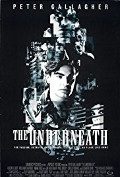
Directed by
Steven Soderbergh
99 minutes
Rated M
Reviewed by
Bernard Hemingway

The Underneath
A remake of the 1949 Robert Siodmak film noir Criss Cross which was based on a novel of that name by crime writer Don Tracy, The Underneath is a more satisfying affair that corrects a good deal of the shortcomings of the earlier version but, surprisingly, not as much as one would wish.
Michael Chambers (Peter Gallagher, who had starred in Soderbergh's 1989 indie hit, Sex. Lies and Videotape) returns to his Austin, Texas hometown where he grew up and departed from suddenly a couple of years earlier to escape his gambling debts. He’s a reformed man but can’t get over the loss of his former wife, Rachel (Alison Elliott), who is now seeing a bar owner and small-time crook, Tommy Dundee (William Fichtner). This fatal attraction leads him into cahoots with Dundee and an armoured truck robbery that goes wrong.
Although Soderbergh largely strips out the film noir antecedents and improves the plot, the story, which is set in the modern day, is essentially the same. The biggest improvement of Soderbergh’s version is in the profiling of the lead male protagonist. Endowing Michael with an addictive personality makes his behaviour more credible than it was with Lancaster’s essentially honest victim. Soderbergh brings out the core idea that here we have someone who wants something for nothing. He also rightly makes Michael’s police detective friend from the earlier version into Michael’s brother (Adam Trese) and suggests some kind of past failing on Michael’s part. It still doesn’t really explain what Michael was trying to achieve by the robbery but it feels a good deal more plausible as an act of desperation. The character of Rachel however is still unconvincing. Her behaviour is very much in keeping with the femme fatale model of the earlier version but that doesn’t work in a modernized context and Soderbergh doesn’t do anything to make her liaison with Fichtner’s bullying thug (a one-to-one updated version of Dan Duryea’s Slim Dundee in the 1949 film) credible. In this respect her final turnabout is, if anything, even less convincing that it was in the original.
The film’s tripartite time structure within which Soderbergh jumps around is also rather wearing. Like the earlier version the present is the day of the heist established with an opening shot in acidulous green of Michael driving the armoured truck. The story of how he got there is told in a dual flashback: the immediate past and his return to town and the time when Michael was still married to Alison. In the latter Michael has a beard, in the former he is clean-shaven. You need these two markers as everything else looks pretty much the same.
So…although the plotting is better (one might however question the need for Elisabeth Shue’s character) and there is more psychological substance here than was the case with the schematic original Soderbergh’s version leaves plenty of room for improvement in a story worth getting right.
Want something different?





